Fuel Injector (W/ Dpf) -- Installation |
- NOTICE:
- When replacing the injectors (including shuffling the injectors between the cylinders), common rail or cylinder head, it is necessary to replace the injection pipes with new ones.
- When replacing the fuel supply pump, common rail, cylinder block, cylinder head, cylinder head gasket or timing gear case, it is necessary to replace the fuel inlet pipe with a new one.
- After removing the injection pipes and fuel inlet pipe, clean them with a brush and compressed air.
| 1. INSTALL INJECTOR ASSEMBLY |
- NOTICE:
- Be sure to install each injector, No. 1 nozzle holder clamp, washer and bolt to its original position.
Install 4 new injection nozzle seats to the cylinder head.
 |
Apply a small amount of clean engine oil to 4 new O-rings.
Install one of the O-rings to each injector as shown in the illustration.
Text in Illustration *1 New O-Ring
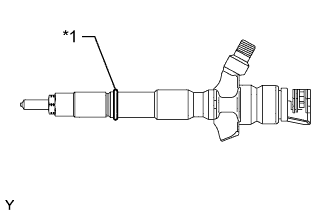 |
Insert the 4 injectors into the cylinder head.
- NOTICE:
- Insert the injector until it touches the injection nozzle seat surface.
- After installing the injector to the cylinder head, the O-ring may prevent the injector from being fully seated. If so, pull out the injector and reinstall it.
- Always reinstall an injector to the same place it was removed from.
For an injector that has been replaced with a new injector, register the injector compensation code (HILUX_TGN26 RM0000012XK070X_02_0003.html).
Temporarily install 4 new washers and the 4 No. 1 nozzle holder clamps with the 4 bolts.
Text in Illustration *1 New Washer *a Downward - NOTICE:
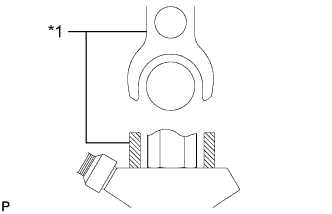
- The fork portion of the No. 1 nozzle holder clamp must be set on the injector.
- Before tightening the bolts, check that the No. 1 nozzle holder clamps are set properly.
- When installing the clamp bolts, first tighten them by hand until they cannot be turned further. Then, tighten the bolts to the specified torque in a following step.
- When tightening the bolts, be careful so as not to tilt the bolt or clamp.
- Do not reuse the washer.
Text in Illustration *1 No. 1 Nozzle Holder Clamp - HINT:
- Apply a small amount of engine oil to the threads and under the heads of the clamp bolts.
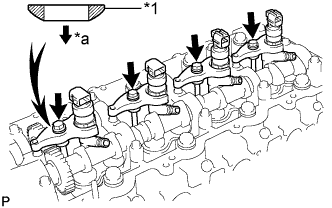 |
Temporarily install the 4 injection pipes with the union nuts.
- HINT:
- To position the injectors, loosely tighten the union nuts.
Check the nozzle leakage pipe. Check that there are no scratches or dents on the 5 union seal surfaces.
If scratches or dents are present, replace the nozzle leakage pipe.
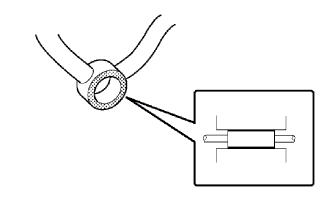 |
Set the nozzle leakage pipe and 5 new gaskets in place.
Text in Illustration *1 Union Bolt
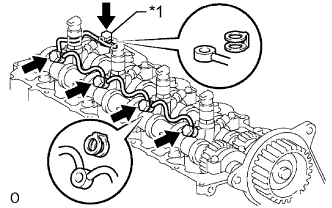 |
Apply a small amount of oil to the 4 injector hollow screws and union bolt.
Temporarily install the nozzle leakage pipe with the 4 injector hollow screws and union bolt.
Tighten the 4 nozzle holder clamp bolts.
- Torque:
- 22 N*m{220 kgf*cm, 16 ft.*lbf}
Remove the 4 injection pipes.
Tighten the 4 injector hollow screws in order from 1 to 4.
- Torque:
- 16 N*m{163 kgf*cm, 12 ft.*lbf}
Text in Illustration *1 Union Bolt - NOTICE:
- If an injector hollow screw is accidentally tightened beyond the torque specification, it must be replaced.
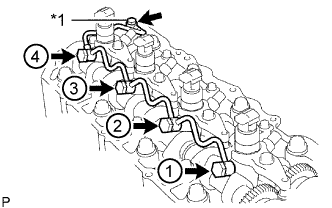 |
Tighten the union bolt.
- Torque:
- 13 N*m{127 kgf*cm, 9 ft.*lbf}
- NOTICE:
- If the union bolt is accidentally tightened beyond the torque specification, it must be replaced.
| 2. INSPECT FOR FUEL LEAK |
Check that there are no leaks from the nozzle leakage pipe connection.
Install a new gasket and the No. 2 nozzle leakage pipe to the cylinder head with SST (check valve).
- Part No.:
- 23762-27010 (No. 2 nozzle leakage pipe)
- SST
- 09280-00010
- Torque:
- 21 N*m{214 kgf*cm, 15 ft.*lbf}
Apply a small amount of soapy water (or other fluid for detecting fuel leakage) on the nozzle leakage pipe connection.
Install SST (turbocharger pressure gauge) to the fuel return side of the nozzle leakage pipe, maintain 100 kPa (1.0 kgf/cm2, 15 psi) of pressure for 60 seconds and check that no bubbles form.
- SST
- 09992-00242
After checking for fuel leaks, wipe off the soapy water from the nozzle leakage pipe connection.
Remove SST, the No. 2 nozzle leakage pipe and gasket.
- NOTICE:
- Never reinstall the disassembled union bolt to the engine.
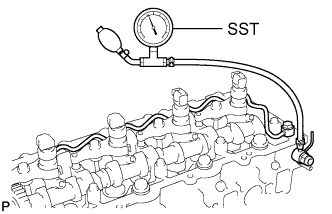
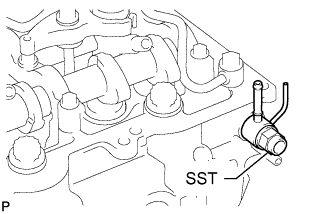 |
| 3. INSTALL CYLINDER HEAD COVER SUB-ASSEMBLY |
Install 4 new No. 3 cylinder head cover gaskets to the cylinder head cover in the directions shown in the illustration.
Text in Illustration *1 No. 3 Cylinder Head Cover Gasket *2 Cylinder Head Cover - NOTICE:
- Do not install the No. 3 cylinder head cover gaskets at an angle.
- Check that there is no foreign matter at the installation location of the No. 3 cylinder head cover gaskets.
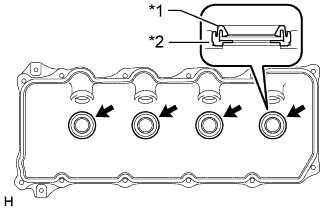 |
Remove any old seal packing (FIPG material) from the cylinder head.
Apply seal packing to the areas shown in the illustration.
- Seal packing:
- Toyota Genuine Seal Packing Black, Three Bond 1207B or equivalent
Text in Illustration 
Seal Packing - NOTICE:
- Remove any oil from the contact surface.
- Install the cylinder head cover within 3 minutes after applying seal packing.
- Do not start the engine for at least 2 hours after installing the cylinder head cover.
 |
Install a new cylinder head cover gasket to the cylinder head cover.
Temporarily install the cylinder head cover with the 10 bolts and 2 nuts in the order shown in the illustration. Then, tighten the 10 bolts and 2 nuts in the order shown in the illustration in 2 progressive steps.
- Torque:
- 9.0 N*m{92 kgf*cm, 80 in.*lbf}
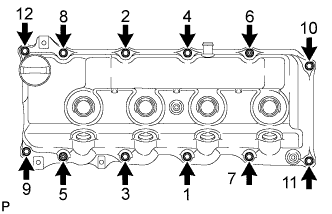 |
Connect the ventilation hose.
Install 4 new nozzle holder seals.
| 4. INSTALL NO. 2 CYLINDER HEAD COVER SUB-ASSEMBLY |
Install the No. 2 cylinder head cover with the 3 bolts.
- Torque:
- 8.0 N*m{82 kgf*cm, 71 in.*lbf}
| 5. INSTALL NO. 2 NOZZLE LEAKAGE PIPE ASSEMBLY |
Temporarily install the No. 2 nozzle leakage pipe with the 2 bolts.
Text in Illustration 
Union Bolt
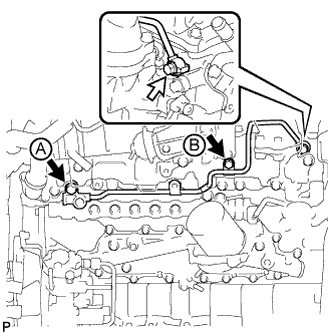 |
Temporarily install a new gasket and the union bolt.
Tighten the 2 bolts and union bolt.
- Torque:
- for bolt A:
- 21 N*m{214 kgf*cm, 15 ft.*lbf}
- for bolt B:
- 13 N*m{130 kgf*cm, 9 ft.*lbf}
- for union bolt:
- 21 N*m{214 kgf*cm, 15 ft.*lbf}
| 6. INSTALL NO. 3 NOZZLE LEAKAGE PIPE |
Apply a light coat of fuel to the O-ring of the fuel check valve.
Text in Illustration *1 O-Ring
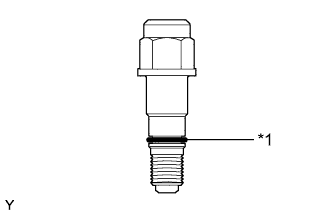 |
Temporarily install the No. 3 nozzle leakage pipe with the 2 bolts.
Text in Illustration 
Fuel Check Valve
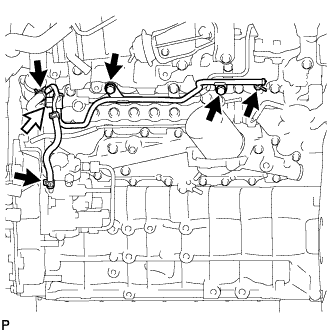 |
Temporarily install a new gasket and the fuel check valve.
Tighten the 2 bolts and fuel check valve.
- Torque:
- for bolt:
- 13 N*m{130 kgf*cm, 9 ft.*lbf}
- for fuel check valve:
- 32 N*m{321 kgf*cm, 23 ft.*lbf}
Connect the 3 fuel hoses.
| 7. INSTALL NO. 2 FUEL PIPE |
Apply a light coat of fuel to the O-ring of the fuel check valve.
Text in Illustration *1 O-Ring
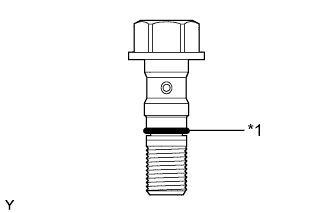 |
Temporarily install the No. 2 fuel pipe with the 3 bolts.
Text in Illustration *1 Gasket *2 No. 1 Fuel Pipe 
Bolt 
Supply Pump Hollow Screw 
Fuel Check Valve 
Union Bolt
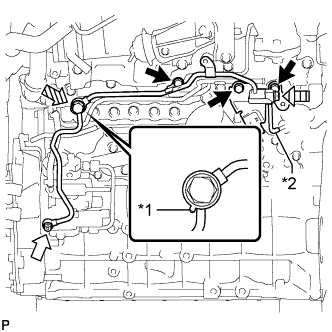 |
Install a new gasket to the No. 1 fuel pipe and temporarily install the union bolt.
Temporarily install a new gasket and the fuel check valve.
- NOTICE:
- When temporarily installing the fuel check valve, position the gasket as shown in the illustration.
Temporarily install a new gasket and the supply pump hollow screw.
Using a 6 mm hexagon wrench, tighten the supply pump hollow screw.
- Torque:
- 21 N*m{214 kgf*cm, 15 ft.*lbf}
Tighten the 3 bolts, fuel check valve and union bolt.
- Torque:
- for bolt:
- 20 N*m{204 kgf*cm, 15 ft.*lbf}
- for fuel check valve:
- 32 N*m{321 kgf*cm, 23 ft.*lbf}
- for union bolt:
- 21 N*m{214 kgf*cm, 15 ft.*lbf}
- NOTICE:
- When tightening the fuel check valve, replace the gasket if it becomes deformed.
| 8. INSTALL WIRING HARNESS CLAMP BRACKET |
Install the wiring harness clamp bracket with the bolt.
- Torque:
- 13 N*m{128 kgf*cm, 9 ft.*lbf}
Attach the wire harness clamp.
| 9. INSTALL NO. 4 INJECTION PIPE SUB-ASSEMBLY |
- NOTICE:
- When replacing an injector, it is necessary to replace the 4 injection pipes with new ones.
- Keep the joints of the injection pipe clean.
Temporarily install the No. 4 injection pipe with the union nuts.
Install the 2 No. 2 injection pipe clamps with the bolt and nut.
- Torque:
- 5.0 N*m{51 kgf*cm, 44 in.*lbf}
Using a 17 mm union nut wrench, tighten the injection pipe union nut on the common rail side.
- Torque:
- 35 N*m{357 kgf*cm, 26 ft.*lbf}
- NOTICE:
- Use the formula to calculate special torque values for situations where a union nut wrench is combined with a torque wrench (HILUX_TGN26 RM000004QR1006X.html).
Using a 17 mm union nut wrench, tighten the injection pipe union nuts on the injector side.
- Torque:
- 35 N*m{357 kgf*cm, 26 ft.*lbf}
- NOTICE:
- Use the formula to calculate special torque values for situations where a union nut wrench is combined with a torque wrench (HILUX_TGN26 RM000004QR1006X.html).
| 10. INSTALL ELECTRIC EGR CONTROL VALVE ASSEMBLY WITH NO. 2 EGR VALVE AND EGR COOLER |
| 11. CONNECT CABLE TO NEGATIVE BATTERY TERMINAL |
- NOTICE:
- When disconnecting the cable, some systems need to be initialized after the cable is reconnected (HILUX_TGN26 RM000004QR300CX.html).
| 12. ADD ENGINE COOLANT |
- CAUTION:
- Do not remove the radiator reservoir cap while the engine and radiator are still hot. Pressurized, hot engine coolant and steam may be released and cause serious burns.
Loosen the radiator drain cock plug.
- HINT:
- Collect the coolant in a container and dispose of it according to the regulations in your area.
Drain the coolant by removing the radiator reservoir cap and, using a wrench, remove the vent plug.
 |
Loosen the cylinder block drain cock plug.

Text in Illustration *1 Radiator Reservoir *2 Radiator Reservoir Cap *3 Vent Plug *4 Cylinder Block Drain Cock Plug *5 Radiator Drain Cock Plug - -
| 13. BLEED AIR FROM FUEL SYSTEM |
Using the hand pump mounted on the fuel filter cap, bleed the air from the fuel system. Continue pumping until the pump resistance increases.
- NOTICE:
- Hand pump pumping speed: Max. 2 strokes/ sec.
- The hand pump must be pushed with a full stroke during pumping.
- When the fuel pressure at the supply pump inlet port reaches a saturated pressure, the hand pump resistance increases.
- If pumping is interrupted during the air bleeding process, fuel in the fuel line may return to the fuel tank. Continue pumping until the hand pump resistance increases.
- If the hand pump resistance does not increase despite consecutively pumping 200 times or more, there may be a fuel leak between the fuel tank and fuel filter, the hand pump may be malfunctioning, or the vehicle may have run out of fuel.
- If air bleeding using the hand pump is incomplete, the common rail pressure does not rise to the pressure range necessary for normal use, and the engine cannot be started.
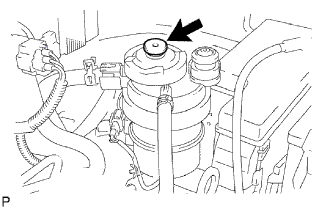 |
Check if the engine starts.
- NOTICE:
- Even if air bleeding using the hand pump has been completed, the starter may need to be cranked for 10 seconds or more to start the engine.
- Do not crank the engine continuously for more than 20 seconds. The battery may be discharged.
- Use a fully-charged battery.
When the engine can be started, proceed to the next step.
If the engine cannot be started, bleed the air again using the hand pump until the hand pump resistance increases (refer to the procedures above). Then start the engine.
Turn the ignition switch off.
Connect the intelligent tester to the DLC3.
Turn the ignition switch to ON and turn the intelligent tester on.
Clear the DTCs (HILUX_TGN26 RM000000PDK0X3X.html).
Start the engine.*1
Enter the following menus: Powertrain / Engine / Active Test / Test the Fuel Leak.*2
Text in Illustration *a Reference
(Active Test Operation)
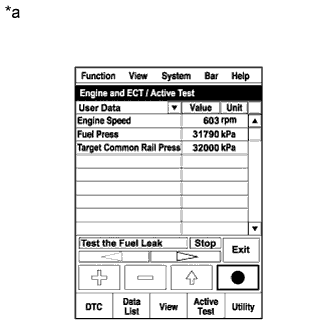 |
Perform the following test 5 times with on/off intervals of 10 seconds: Active Test / Test the Fuel Leak.*3
Allow the engine to idle for 3 minutes or more after performing the Active Test for the fifth time.
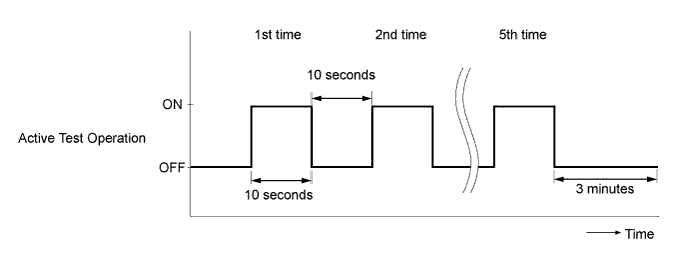
- HINT:
- When the Active Test "Test the Fuel Leak" is used to change the pump control mode, the actual fuel pressure inside the common rail drops below the target fuel pressure when the Active Test is off, but this is normal and does not indicate a pump malfunction.
Enter the following menus: Powertrain / Engine / DTC.
Read Current DTCs.
Clear the DTCs (HILUX_TGN26 RM000000PDK0X3X.html).
- HINT:
- It is necessary to clear the DTCs, as DTC P1604 or P1605 may be stored when air is bled from the fuel system after replacing or repairing fuel system parts.
Repeat steps *1 to *3.
Enter the following menus: Powertrain / Engine / DTC.
Read Current DTCs.
- OK:
- No DTCs are output.
| 14. PERFORM REGISTRATION |
Perform registration of the injector compensation codes (HILUX_TGN26 RM0000012XK070X_02_0003.html).
Perform pilot quantity learning (HILUX_TGN26 RM0000012XK070X.html).
| 15. INSPECT FOR COOLANT LEAK |
- CAUTION:
- Do not remove the radiator reservoir cap while the engine and radiator are still hot. Pressurized, hot engine coolant and steam may be released and cause serious burns.
- NOTICE:
- Before each inspection, turn the A/C switch off.
Fill the radiator with coolant and attach a radiator cap tester.
Warm up the engine.
Using the radiator cap tester, increase the pressure inside the radiator to 118 kPa (1.2 kgf/cm2, 17 psi), and check that the pressure does not drop.
If the pressure drops, check the hoses, radiator and water pump for leaks. If no external leaks are found, check the heater core, cylinder block and head.
| 16. INSPECT FOR FUEL LEAK |
Perform the Active Test.
Connect the intelligent tester to the DLC3.
Turn the ignition switch to ON.
Turn the intelligent tester on.
Enter the following menus: Powertrain / Engine / Active Test.
Perform the Active Test.
Intelligent Tester Display Test Part Control Range Diagnostic Note Test the Fuel Leak Pressurize common rail interior and check for fuel leaks Stop/Start - The fuel pressure inside the common rail increases to the specified value and the engine speed increases to 2000 rpm when the Active Test is performed.
- The above conditions are maintained while the Active Test is being performed.
- The fuel pressure inside the common rail increases to the specified value and the engine speed increases to 2000 rpm when the Active Test is performed.
| 17. INSPECT FOR OIL LEAK |
Start the engine. Make sure that there are no oil leaks from the areas that were worked on.
| 18. INSPECT ENGINE OIL LEVEL |
Warm up the engine, stop the engine and wait 5 minutes. The engine oil level should be between the dipstick low level mark and full level mark.
If low, check for leakage and add oil up to the full level mark.- NOTICE:
- Do not fill engine oil above the full level mark.